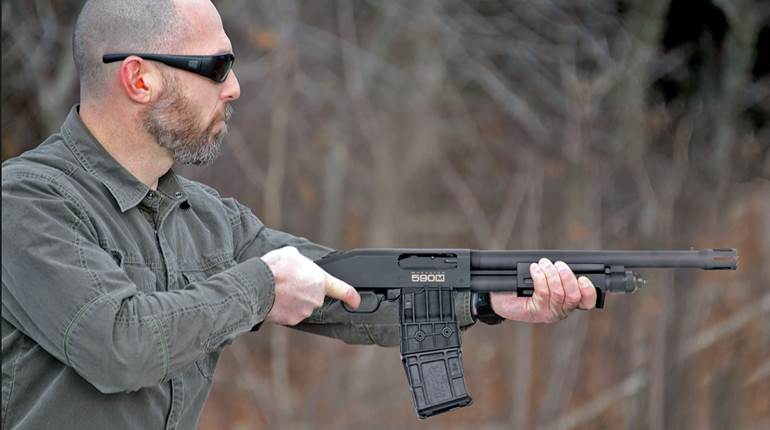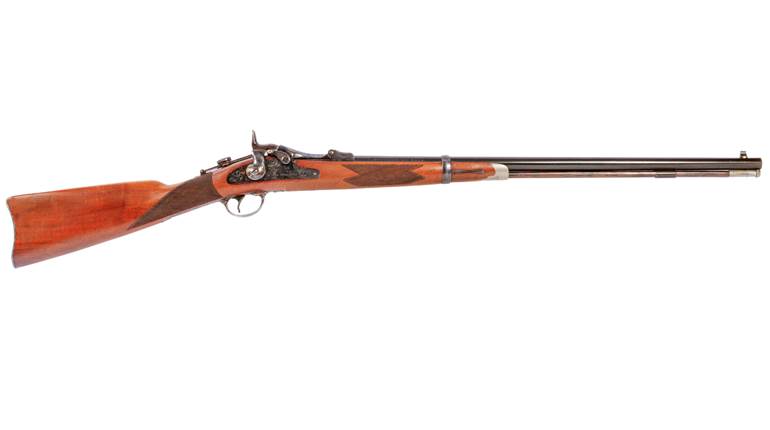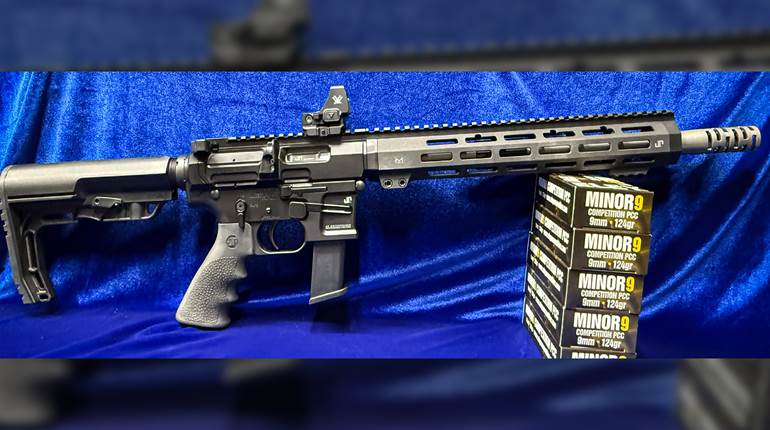
I’ve never really been a car guy. That said, new stuff catches my eye, but there’s something about an old-school kind of cool, like the old square-body trucks. Their aesthetic, function and utility all still hold up. The same can be said of firearms, too. For instance, the ever-popular AR-15 platform is here to stay, but just because it’s popular doesn’t mean there aren’t other options worth considering. Older guns or guns that have different feature sets—especially semi-automatic platforms—still hold value. Here’s why.
 Developed by the ArmaLite Division of Fairchild Engine & Airplace Corp. in the late 1950s, the first AR-15 (shown above) came as a lightweight companion and scaled-down copy of the AR-10 platform and designed specifically for the .223 Remington cartridge, which was an adaptation of the .222 Remington. Note the included optic, bipod and flash suppressor..
Developed by the ArmaLite Division of Fairchild Engine & Airplace Corp. in the late 1950s, the first AR-15 (shown above) came as a lightweight companion and scaled-down copy of the AR-10 platform and designed specifically for the .223 Remington cartridge, which was an adaptation of the .222 Remington. Note the included optic, bipod and flash suppressor..
Design
AR-style firearms—particularly the AR-15—are often thought of as a do-all gun, mostly because of their modularity (we’ll get to that in a second). But just because some gun can be modified, doesn’t necessarily mean they’re an ideal platform when modified, or that people should readily engage in modifying the design if other options are available. The concept of the original AR was to simply create a more modern platform for military use, and Eugene Stoner-designed platform ended up as our principal service rifle because it provided performance characteristics desired at the time, in its originally designed format and chambering.
Additionally, parts interchangeability between rifles and modifying a gun to shoot something entirely different than originally intended are two different things. This is why guns like the Springfield M1A, which was specifically designed to shoot the .308 Win. round, have far fewer failure rates than many modified AR-15s. Sure, it’s heavier, doesn’t have the ammo capacity, can’t be customized as easily, etc., but that’s because it wasn’t designed to be. The entire gun was designed around the .308 Win. cartridge, so it’s optimized for that specific round.

Another example is that Browning now offers the BAR in short-action calibers, but that’s because Browning redesigned the entire gun to do so in 1967 when it launched the “sporting” version we commonly see today; it’s not the same BAR your great-grandad carried in the Army, except in name only.
Similarly, so, too, was the AR-15, until people started messing with it, and began changing the design with different parts, which increased the number of potential problems and failures. That old phrase, “If it ain’t broke, don’t fix it,” wasn’t adhered to in the AR’s case, and now we have people modifying their guns who do not understand that while it’s technically possible, it wasn’t necessarily designed for that. And they wonder why they have problems with their gun.
Modification
Aside from not being designed for certain things, as stated, people tend to mix and match parts with their ARs. Again, this is a can vs .should argument. For instance, many AR-15 manufacturers know how to build a gun. SIG Sauer won several military contracts because the company’s engineers know how to build guns. Can you piecemeal a gun together from spare parts, modifying things to make them fit like they should, so it kind of, maybe, hopefully works? Sure. Or you could not mess with what an entire company developed through extensive testing and R&D and leave it alone. If you want something different, it’s probably worth buying a different variant from a manufacturer who developed that variant specifically.
The AR itself is somewhat at fault for this, because modifying your gun is now encouraged, even if you don’t know what you’re doing. The problems with modifications range from minor to major; a quick Google search can provide several examples of someone who made the simple mistake of putting a .300 Blackout round in a 5.56 NATO chamber on an AR-15. Even simply changing uppers and forgetting you did so can cause catastrophic damage. And that’s only from popping two pins out and changing an upper, which is a relatively simple task. Some might say that’s user error instead of any fault with the design, but considering how vastly different ARs can be inside while looking functionally the same from a visual and use perspective certainly doesn’t help.

The DIY concept of putting together your own rifle also brings with it a whole other set of risks. Sure, AR components are generally interchangeable, but quality-control issues with one part might bring about failures. Is it likely? No. Is it more likely than if you just bought a preassembled gun and didn’t modify it? Certainly. And considering how easily the AR-15 can be modified with aftermarket parts, it’s likely that those engaged in such work aren’t clued into what to watch out for to prevent failures.
A case study here can be seen between this NRA member’s efforts to build a functioning AR-15 in 7.62x39 mm and the Mk47 developed by CMMG, Inc. Both are AR-style rifles chambered in a cartridge wildly different from the round originally developed for the AR-15. One took much diligent effort and experimentation to perfect, and the other can be bought off the shelf with zero issues.
Reliability
Modifying a gun at the very least increases the probability of minor failure rates, like timing and cycling issues, or increased wear, by making modifications and changing things the gas-tube length when going to a different barrel length to try to get the system to work. In that case, you’ve still hurt your chances here, as the gun might not be dangerous, but it’s probably not reliable. One case in point is the development process other companies go through to dial-in gas systems.
For example, per a former FN product manager, the SCAR platform underwent various testing protocols for almost five years as FN tested—and abused—the SCAR before FN officially launched its renowned SCAR platform. For the average shooter, the likelihood you’ll shoot more than a firearms manufacturer during testing a new product design like the SCAR is highly improbable, to say the least.
 Originally engineered for the .223 Rem. (5.56 NATO) cartridge, today, many AR-15s are nothing like the initial design, with chambering options that push the extreme limits of performance, which oftentimes induces problems, both at the range and the workbench. Note the author's .458 SOCOM-chambered AR shown above.
Originally engineered for the .223 Rem. (5.56 NATO) cartridge, today, many AR-15s are nothing like the initial design, with chambering options that push the extreme limits of performance, which oftentimes induces problems, both at the range and the workbench. Note the author's .458 SOCOM-chambered AR shown above.
To further highlight this, let’s look at guns like the M1911 pistol. There’s a very specific spring poundage when considering different cartridges that can be fired out of an M1911. The 9 mm Luger, 10 mm Auto and .45 ACP cartridges do not create the same pressures, which means the guide rod spring needs to match the cartridge fired to ensure proper cycling. The M1911—and most other semi-auto pistols—solely rely on that one spring. Start tweaking buffer weights, buffer springs and the gas system on an AR-15, and the odds of encountering an issue increases. Sure, you have more to tinker with to fix a problem if it occurs. Or you could just stick with what is known to work and not have to tinker in the first place. You’d have a gun that was designed to be reliable, rather than made to look a certain way or meet a certain level of “cool.” This gun would not fail to feed because parts that were supposed to work in conjunction were mismatched and not designed from start to finish to complement one another in function.
Aftermarket Compatibility
Some guns, like the Browning BAR and the Springfield M1A, don’t have as much aftermarket support as the AR platform, in terms of action parts and components, but they don’t necessarily need it. Because the guns simply work. There are so few manufacturers of aftermarket parts for the BAR and M1A for example, that what does exist will also almost certainly work, because if it didn’t, it wouldn’t be on the market to start with due to lack of a broad consumer base to support the company in question and its products. Conversely, because of the incredibly wide market of AR-15 users and tinkerers, the odds of running across parts and modifications that cause issues is exponentially greater.
 While most components are true to the AR-15 lineage of the Rock River LAR-47 X-1 rifle (above), the gun's lower receiver is designed to accept the unmistakable curved magazine of the AK-47 of which feeds 7.62x39 mm cartridges.
While most components are true to the AR-15 lineage of the Rock River LAR-47 X-1 rifle (above), the gun's lower receiver is designed to accept the unmistakable curved magazine of the AK-47 of which feeds 7.62x39 mm cartridges.
Then this leads companies develop even more products to accommodate all the tinkering. Some companies makes a .300 Blackout-specific magazine, for example, because they saw a problem when consumers used a standard 5.56 NATO magazine for .300 Blackout-chambered guns; it didn’t always work reliably. LWRC made a special 6.8 SPC lower (with Magpul making proprietary magazines for LWRC’s specific 6.8 SPC)—and entire rifle—based around the 6.8 SPC for the same reason. Just because many aftermarket parts can be combined to shoot the 6.8 SPC doesn’t mean it works well.
LWRC explained the reason far more technically: “A major drawback of using the 6.8 Cartridge in an M4 style weapon has been the lack of reliable magazines. To solve this issue, we designed our SIX8 family of weapons around the magazine. Through a partnership with Magpul, the leader in polymer magazine engineering, we designed the first polymer 6.8 magazine. The SIX8 PMAG features many of the same design characteristics of the standard PMAG, including the curved shape and familiar texture. The body is slightly wider, and the walls were strengthened in critical areas. Our red follower makes the SIX8 magazine easy to pick out of a pile.”
There is enough popularity for the AR-15 platform that knock-offs certainly exist, and using subpar parts won’t end well, which is why sometimes it pays to play in a niche market where even aftermarket support is well-vetted.
Cost
Many people assume that the AR-platform is more budget-friendly than some of these other classic, renowned firearms, and that’s why it’s so popular. It certainly can be, depending on some variables, like using subpar components and building it yourself. But we already decided that might not be the best idea. With that in mind, assuming the chambering is the same, a well-built, company-tested, AR-style rifle designed to fire a particular cartridge isn’t that much cheaper.
The average Browning BAR will run you anywhere from about $1,200 to $2,000 new (barring special editions). An M1A? Just under $1,800 to just over $2,500. That sounds steep. But look at the cost of some of Daniel Defense’s AR-10 rifles. Most models are just under $3,000, with a few crossing that threshold.

Want a semi-auto .300 Win. Mag.? You can get a semi-auto BAR chambered for the round for less than $2,000 pretty easily. An AR platform in .300 Win. Mag.? As far as I know, Nemo Arms is the only company that makes a solid one, so by default, Nemo is the premier long-action AR manufacturer. Developing a .300 Win. Mag. variant of a modified AR-platform rifle is no small task. But at a starting price of $4,900 and going up to as much as $6,700 for the top-tier Omen rifle model, it isn’t the most “fiscally responsible” option if one is looking for that kind of performance. For a quick comparison, here are the few rifles discussed just to summarize the concept:
|
Model |
Lowest MSRP |
Top-Dollar MSRP |
|
Browning BAR (.308 Win.) |
$1,679.99 |
$1,829.99 |
|
Springfield M1A (.308 Win.) |
$1,770.00 |
$2,540.00 |
|
Daniel Defense AR-10 (.308 Win.) |
$2,731.00 |
$3,050.00 |
|
Browning BAR (.300 Win. Mag.) |
$1,599.99 |
$1,929.99 |
|
Nemo Omen (.300 Win. Mag). |
$4,900.00 |
$6,700.00 |
What does this mean? Really, the AR platform, with as much supply as there is, doesn’t actually help in the cost department like one would think it should based on simple economics. With all these considerations in mind, the AR platform might not be everything it’s cracked up to be. Sometimes, firearm designs that aren’t as common, but are still made by reputable companies, can often be a better alternative, provided it checks all the boxes a consumer wants. Just because it isn’t an AR-platform design shouldn’t be a knock against it. After all, it’s why guns like the Springfield M1A and the Browning BAR are still around today even after newer designs—like the AR platform—came onto the scene decades later.
Don’t get me wrong, I absolutely love the AR-15. I own many, have modified them, and even reload ammo for the guns I’ve modified (see my “Alternative Ammo” pieces in American Hunter). Granted, I’ve had to use a lot of trial and error to resolve an issue I created myself because of my oddball AR projects. Some people enjoy that level of tinkering and troubleshooting and have the knowledge to do it safely and effectively, but not everyone wants to invest the time and money correcting their own self-induced issues. After all, there’s no warranty or guarantee on the quality of workmanship when it comes to DIY projects.
If this sounds like you, then it pays to get it right the first time and buy a proven design backed up by a particular maker. And just like cars, as cool as some new concept might be, there’s something to be said for owning a classic. For those looking to add a classic cartridge/firearm combo to their arsenal, the M1A in .308 Win., the BAR in .30-‘06 Sprg., an AK-47 in 7.62x39 mm, and even some newer models like the FN P90 in 5.7x28 FN or LWRC’s 6.8 SPC AR-15 variant were and continue to be all built around a specific cartridge fired from a specific, specially designed firearm platform. Don’t fall for the hype around the AR-15, because depending on what you’re looking for, there are plenty of other options to consider.





































